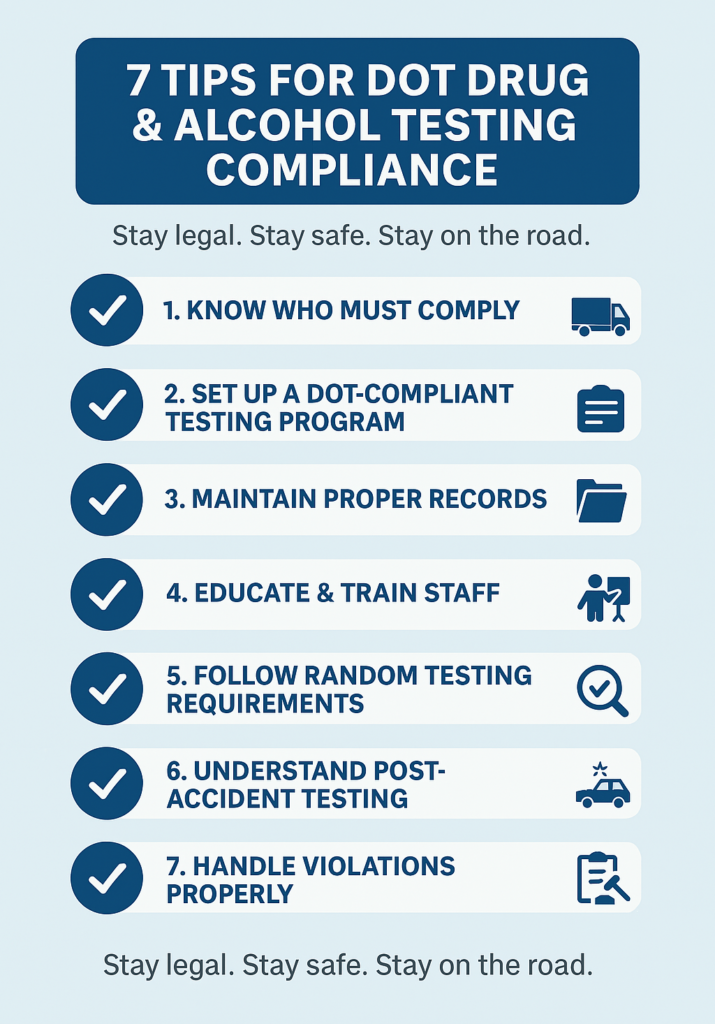If you operate a commercial trucking business or drive a commercial motor vehicle (CMV), staying compliant with Department of Transportation (DOT) drug and alcohol testing regulations is non-negotiable. These rules are designed to ensure driver safety and public protection, and violations can lead to hefty fines, driver disqualification, or loss of operating authority.
To help you understand and meet the requirements, we’ve outlined essential tips for setting up a compliant drug and alcohol testing program and staying in line with DOT rules year-round.
For assistance setting up your program, check out our Drug and Alcohol service.
1. Know Who Is Required to Comply
The DOT drug and alcohol testing regulations apply to all employers and safety-sensitive employees operating CMVs that:
- Require a commercial driver’s license (CDL)
- Have a gross vehicle weight rating (GVWR) of 26,001 lbs. or more
- Transport hazardous materials
- Carry 16 or more passengers, including the driver
If you or your drivers meet any of these conditions, DOT compliance is required.
2. Set Up a DOT-Compliant Testing Program
A compliant testing program must follow the guidelines outlined in 49 CFR Part 40. It should include procedures for:
- Pre-employment testing (before the driver performs any safety-sensitive duties)
- Random testing (conducted throughout the year)
- Post-accident testing (based on DOT criteria)
- Reasonable suspicion testing (if signs of drug or alcohol use are observed)
- Return-to-duty and follow-up testing (after a violation)
Tips for Setting Up the Program:
- Use a certified drug and alcohol testing consortium or third-party administrator (TPA)
- Ensure collection sites and labs are DOT-certified
- Keep all test results and documents secure and confidential
Using a trusted partner like the Drug and Alcohol service ensures your program meets all federal requirements.
3. Maintain Complete and Up-to-Date Records
DOT requires that specific records be kept for different lengths of time, depending on the document type. Failure to maintain these records is a common compliance violation.
Records You Should Keep Include:
- Test results (both positive and negative)
- Random testing selection logs
- Driver consent forms
- Chain-of-custody forms
- Supervisor training certificates (if applicable)
Keep these records organized and readily available in case of a DOT audit.
4. Educate and Train Your Staff
Education is a key part of maintaining compliance. Supervisors and drivers need to understand the testing requirements, consequences, and their responsibilities.
Training Guidelines:
- Supervisors must complete reasonable suspicion training, including 60 minutes on drugs and 60 minutes on alcohol.
- Drivers should receive educational materials on testing procedures, their rights, and DOT policies.
- Provide refresher courses to keep staff up to date with any regulatory changes.
When everyone understands the program, it becomes easier to manage and maintain.
5. Follow the Random Testing Requirements
The DOT mandates that companies randomly test a percentage of their driver pool each year. As of now, the minimum random testing rates are:
- 50% for drugs
- 10% for alcohol
How to Stay Compliant:
- Use a computerized random selection process to ensure fairness
- Spread tests evenly throughout the year
- Notify drivers just before testing and ensure they report immediately
Using a consortium or TPA helps you manage random testing accurately and within regulations.
6. Understand Post-Accident Testing Rules
Post-accident drug and alcohol testing is required in certain cases. Understanding when and how to administer these tests is vital.
DOT Testing Is Required If:
- There was a fatality, regardless of driver fault
- A driver receives a citation and there was injury or disabling damage
Timeframes:
- Alcohol tests must be conducted within 2 hours, but no later than 8 hours
- Drug tests must be conducted within 32 hours
If testing can’t be performed within these windows, you must document the reasons.
7. Handle Violations Properly
If a driver fails a test or refuses to take one, the company must follow strict procedures before the driver can return to duty.
Return-to-Duty Process:
- The driver must see a DOT-qualified Substance Abuse Professional (SAP)
- Complete a treatment or education program as recommended
- Pass a return-to-duty test
- Be subject to follow-up testing (minimum of six tests in the first 12 months)
Failure to follow this process can result in serious penalties for your company.

Final Thoughts
Staying compliant with DOT drug and alcohol testing rules is crucial for the safety, legality, and success of your trucking operation. From setting up a proper testing program to maintaining records and educating your team, every step matters.
For expert help in managing your compliance, visit our Drug and Alcohol service today and keep your business audit-ready and DOT-compliant.





